human physiology Notes
Human physiology
Approaching the topic:
- Understanding the concepts
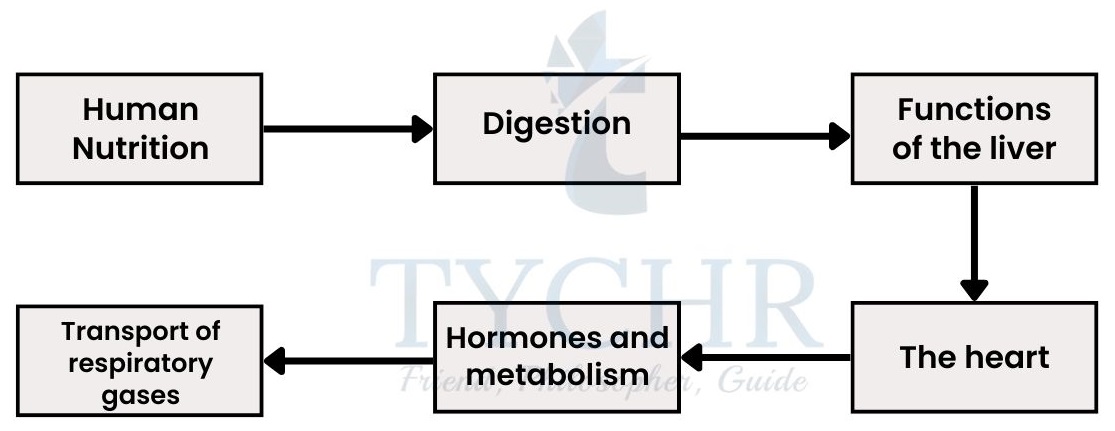
- Application of these concepts
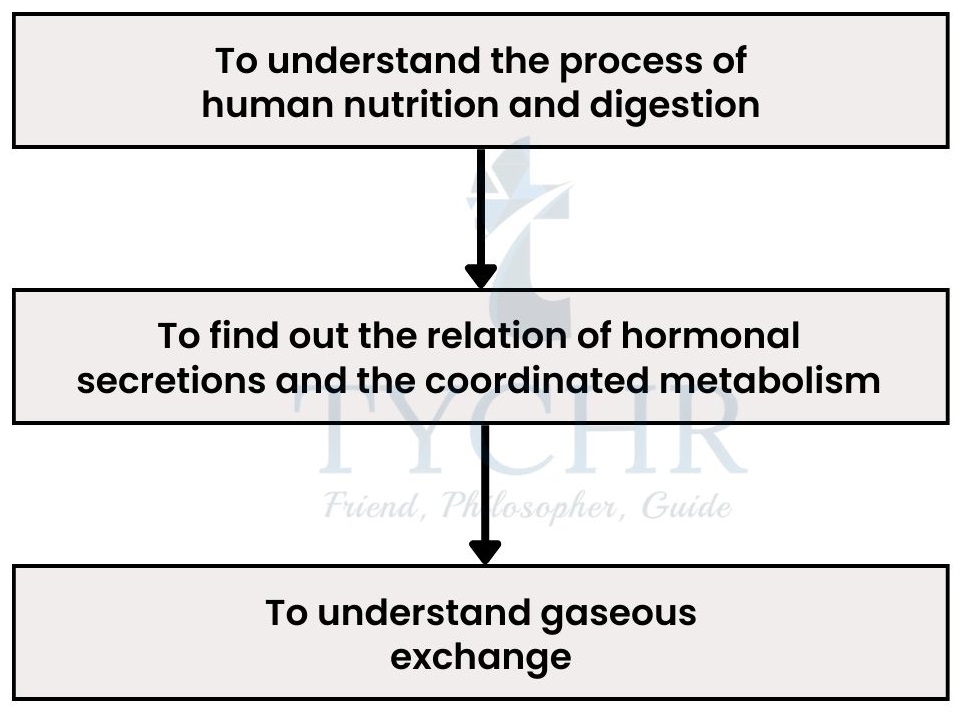
Human nutrition
Essential and non-essential nutrients
- The essential nutrients needed by the human body are:
- Essential amino acids
- Essential fatty acids
- Minerals
- Vitamins
- If the necessary nutrients are synthesised in our bodies by metabolism, then they are called non-essential nutrients and if some nutrients are not getting synthesised in the body but need to be taken as a part of our diet, those are called essential nutrients.
Amino acids
- Out of 20 amino acids, 9 are essential amino acids which are supplied in our regular diet.
- These 9 essential amino acids are; Valine, phenylalanine, histidine, leucine, isoleucine, tryptophan, threonine, lysine and methionine.
- Deficiency of one or more of the essential amino acids in diet may not lead to necessary protein formation and thus may affect the individuals.
Phenylketonuria (PKU) It is a genetically inherited disease in which, an individual cannot metabolize phenylalanine amino acid. It is due to the mutation in one of the gene that produce an enzyme called phenylalanine hydroxylase, for metabolizing phenylalanine. |
Minerals
- These are the inorganic substances which are mostly taken in the ionic form (i.e. as electrolytes) and are needed in very small quantities.
- Some of the most important minerals are Ca2+, Fe2+,Na+, Mg+ and Cl– ions. Calcium is needed for bones, iron is embedded in haemoglobin molecule, sodium is used in generating action potentials, magnesium is used in muscle functioning and chloride maintains the electrolytic balance in the blood.
- Electrolytic imbalance causes muscle cramps.
Vitamins
- These are organic molecules, which are taken as part of diet but many of them are also synthesised in our body.
- These are also needed in small quantities and plant food is the main source.
- The deficiency may lead to certain specific disease due to certain deficient vitamin.
Such as;- Deficiency of vitamin C (an essential vitamin), also called an ascorbic acid, in the body may cause scurvy.
- Deficiency of vitamin D may cause rickets. In rickets, deformities of bones occur because vitamin D is necessary for better formation of the bones. Leg bones are affected mostly.
- Children are at most risk to be affected by this disease but similar conditions can occur in adults as well, called osteomalacia.
Why minerals and vitamins are needed in very small amounts? Because they make a complex molecule or structure which remains functional for a long period, therefore they need not to be taken in large amounts. How both calcium and vitamin D are essential for bones? Vitamin D is synthesised by precursor molecules found in the epidermis, in the presence of UV rays of sun. When calcium levels are low, parathyroid hormone is released in the blood stream which induces enzyme to convert vitamin D into its active form called calcitriol, which stimulates enhanced absorption of calcium from small intestine. |
Fatty acids
- Omega-3 and omega-6 are the two essential fatty acids that are need to be taken in our diet. Fat is the only source for these two fatty acids to be taken in.
- Fatty acids are marked by their long hydrocarbon chain and a carboxyl group at one end.
- Cholesterols are therefore come out to be beneficial and harmful as well. They are harmful in the way that, plaque formation occurs inside the arteries making them even smaller in diameters, called atherosclerosis. The blockage in the arteries may result in the heart attack.
Malnutrition
- Malnutrition is the result of intake of unbalanced or improper diet. The diet can be unbalanced or fail to provide essential nutrients leading to starvation, or it may have excess amounts of carbohydrates and fats leading to overweight.
- Consequences of overweight: There are two most likely diseases to occur in an individual with overweight;
- Hypertension: More the weight, more the blood would be needed to supply oxygen to every cell in the body. Increase in the volume of blood will increase the blood pressure in the walls of the arteries and therefore causes hypertension.
- Type II diabetes: With overweight, more and more lipids and carbohydrates are getting inside the body which enhances the glucose levels inside the blood. The insulin production gets low, and so the benefit of insulin to remove glucose from the blood also gets reduced.
- If not enough carbohydrates or fats are provided to the individual, then the stored glycogen (in the liver) will be used as a source of glucose. After that, the body fat will be used and if it gets even worse, then proteins will be used as a source of energy.
- Body tissues can also be used at last, starting from the skeletal muscle.
Digestion
Digestive process
- Secretions through exocrine glands are necessary for digestion. Exocrine secretions occur through ducts and on the specific location it is meant to be functional on.
Exocrine gland | Exocrine secretion | Composition | Function |
Salivary glands | saliva | Salivary amylase, mucus, lysozyme | Moistens food and amylase breaks down the starch |
Stomach | Gastric juice | HCl, pepsin, rennin, mucus and water | HCl denatures the proteins, mucus protects the stomach wall |
Pancreas | Pancreatic juice | Enzymes like carboxypeptidase, amylase, lipase and trypsinogen | Helps neutralizing the partially digested food into the duodenum of small intestine. |
Liver | Bile juice | Water, mucus, bile salts, bile pigments and cholesterol | Reduces acid content of chyme, helps in emulsification and absorption of fat molecules |
Gastric secretions
- There are three glandular secretions; HCl, pepsin and mucus which are produced by three glandular cells present in the gastric pits.
- Any sense of food triggers nervous responses in the body. ANS sends impulses to the medulla oblongata which responds by sending action potentials by vagus nerve, directly to the stomach causing it to release HCl, pepsinogen and mucus in the stomach.
- Gastrin (a hormone secreted by endocrine gland) is also released due to this response which results in even more secretion of HCl and pepsinogen.
- When the chyme travels into the duodenum from the stomach, secretin hormone is released which inhibits gastric pit activity.
- HCl helps in denaturing the proteins and killing harmful pathogens, pepsin catalyses the hydrolysis of large polypeptide chains into smaller units.
Stomach ulcers!
- The pH of the fluid in the stomach can be as low as 2, this may cause partial digestion of the lining of the stomach and stomach ulcers. The bacteria called Helicobacter pylori, has a major contributing role in causing ulcers.
- Helicobacter pylori neutralises the acid in the stomach but causes its own infection that leads to gastritis and ulcers or even cancer if prolonged.
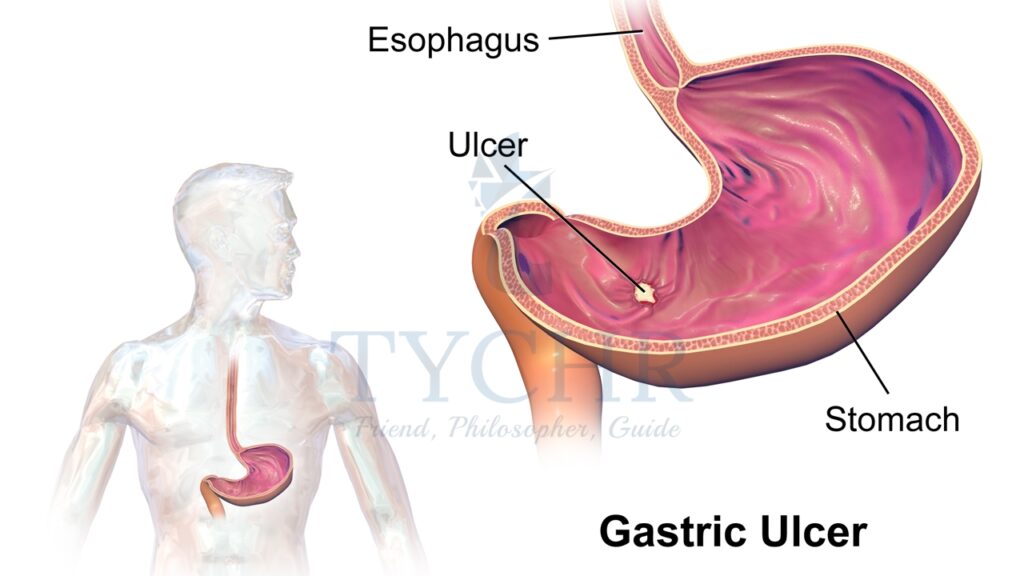
Adaptive Absorption
- Absorption of the digested food occurs in small intestine lined by
- Villi further contain projections called microvilli for even better
- Molecules are absorbed by two ways:
- Through the plasma membrane using active transport mechanism. ATP for active transport is provided by mitochondria present in the
- Through pinocytotic vessels present near to plasma membrane. It is also energy consuming active
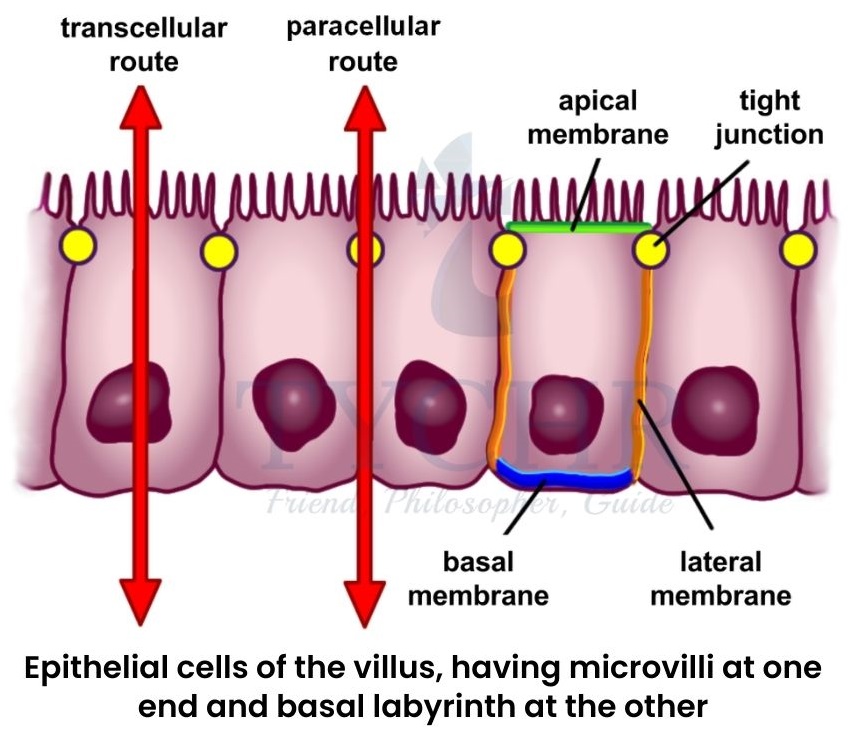
Figure 15.1 epithelial cells of the villus, having microvilli at one end and basal labyrinth at the other
- Basal labyrinth also increases the surface area for efficient transport
- Tight junctions between each epithelial cell ensure that, no molecule can pass through without entering the epithelial
Functions of the Liver
Circulation of blood considering liver
- Two major blood vessels; hepatic portal vein and hepatic artery, flow blood in the liver which exits by only one (hepatic vein).
- The capillaries of the liver which receives blood from the two blood vessels are called sinusoids.
Blood in hepatic portal vein | Blood in hepatic artery | Blood in hepatic vein |
Deoxygenated, low- pressure blood | Oxygenated blood | Deoxygenated, low- pressure blood |
- Oxygen rich blood and nutrient rich blood travel inside the liver for exchange of substances in between the blood and the liver cells (hepatocytes).
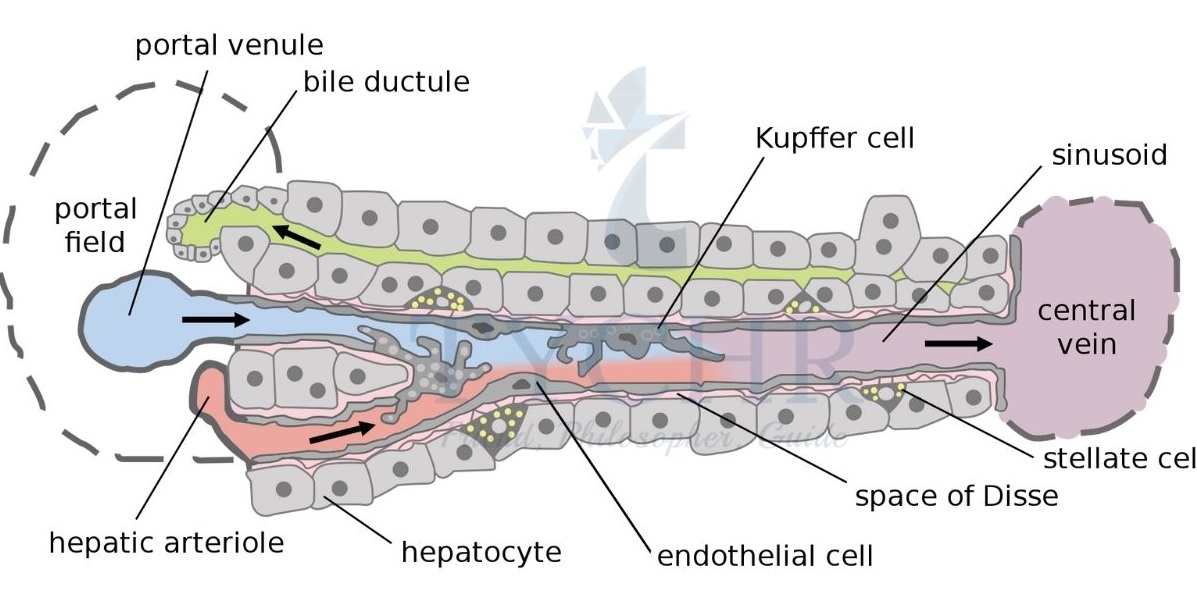
Exchange of substances in between the blood and the liver cells - Specialised leucocyte cells called Kupffer cells are present inside the sinusoids which help in recycling of older erythrocytes by breaking down its haemoglobin.
How sinusoids are different from normal capillary bed?
|
Functions of liver
- The food we eat may contain a number of toxins like the crop is sprayed with pesticides, herbicides etc., added preservatives, flavouring substances etc. Liver comes in action to remove these substances.
- Kupffer cells phagocytose many bacteria in the blood and also contain many lysozymes.Removes toxins from the blood
- Hepatocytes extract toxin from blood plasma, modifies them to weaker molecules and make them water soluble so that they can be eliminated by kidney.
- Regulates nutrients in the blood
- Every time blood passes through liver sinusoids, the exchange of nutrients will occur to maintain the homeostasis of the body.
- Hepatocytes will absorb much of glucose if blood glucose levels are high and if blood glucose levels are low, then the stored glycogen will be converted into glucose and added into the bloodstream.
- This is of course hormonal, taking into account the insulin and glucagon secretion from pancreas.
- Helps in recycling of erythrocytes
- The erythrocytes need to be replaced every 120 days because they die after 4
- Soon after they die, the haemoglobin molecules are released from these cells due to weakening of the cell membranes, in the blood stream. These are phagocytosed by Kupffer cells in sinusoids and dissembled into its
Constituents of haemoglobin!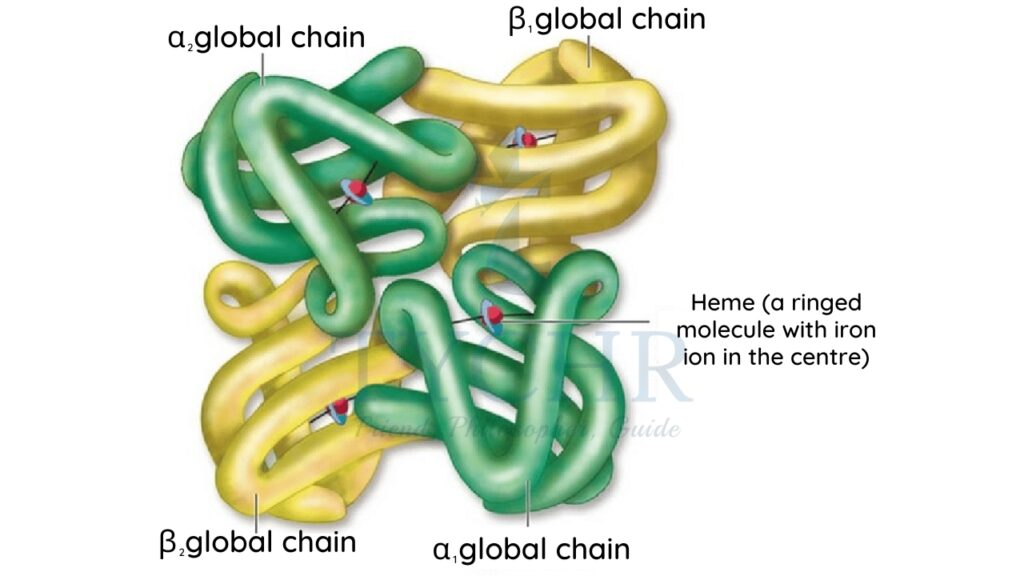
Four globins (polypeptides), four haem groups (one in each globin) and four iron atoms (one in each haem group).
- Activity of Kupffer cells:
- Globin proteins are hydrolysed into amino acids which draw into bloodstream.
- Iron atom is removed, some of it is stored in the liver and rest is sent to bone marrow for production of new erythrocytes.
- The remaining part after iron removal is called bilirubin which is absorbed by hepatocytes and becomes one of the components of bile.
- Secrete bile and plasma proteins:
- Lipid molecules in the food are hard to digest because they clump together, making it difficult for lipase to act upon them.
- Bile juice from the liver breaks up the clump and allows lipase to breakdown lipid molecules.
- Hepatocytes produce plasma proteins which add up in the plasma of the blood.
Jaundice When too much of yellow bilirubin pigment circulates in the blood and hence within the body tissues as well, it causes jaundice. Bilirubin molecules are produced after the death of erythrocytes and are processed in the liver to make bile juice. Infant jaundice occurs when their livers are not yet fully developed to process bilirubin. Adult jaundice also occurs due to non-functioning of liver properly. |
The heart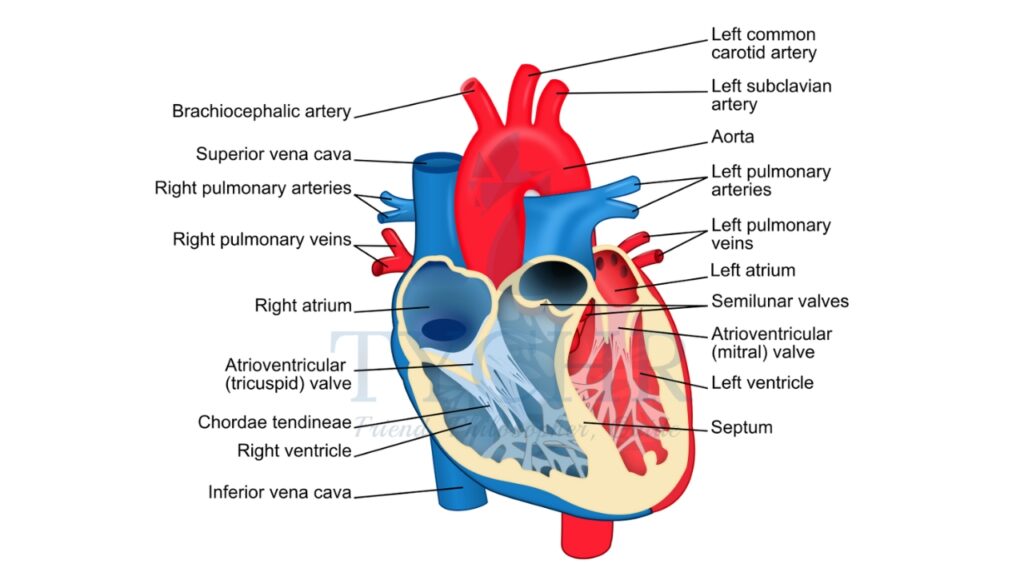
Structure of heart
- Heart is made up of cardiac muscle which has sarcomeres like in skeletal muscle.
- The muscle cells are joined to each other by intercalated discs which helps them to work together as a unit. Also they have disc-shaped openings called gap junctions through which the cytoplasm of the cells can pass. This allows an electrical signal to pass quickly from one cell to another.
- Cardiac muscle tissues have large mitochondria and are highly vascular so as to prevent them from getting fatigue.
Heart valves:
- Two atrioventricular valves on left and right side of the heart, separating left atrium from left ventricle and right atrium from right ventricle. These two valves are called bicuspid or mitral valve and tricuspid valve respectively on the left and right side.
- Left and right semilunar valves are also present on the left and right side of the heart. Left semilunar valve, also called aortic valve separates left ventricle and its outlet of Right semilunar valve, also called pulmonary valve separates right ventricle and its outlet of blood.
- The sounds of the heart i.e. lub and dub comes from the closure of these valves timely.
Wonder! What prevents the backflow of the blood into vena cava and pulmonary veins while entering atria? Veins have valves (one of the difference between artery and veins), which are curved in the direction of flow of blood. So if the blood attempts to backflow, the valves straighten up and closed the way, preventing backflow of the blood. Also the pressure built by atria upon contraction is very slight which does not overcome the activity of the valves. |
Heart rate mechanism
- Heart is wholly made up of muscles known as cardiac muscles. These muscles contract and relax spontaneously and this phenomenon is called myogenic muscle contraction. It is not controlled by the nervous system.
- A specialised tissue called sinoatrial node (SA node) is present in the right atrium, it is also known as pacemaker. SA nodes have the properties of both muscles and nervous system.
- SA node sends the signal after every 0.8 seconds to initiate the contraction of both the atria and the same signal is received by AV node (atrioventricular node) which further after the delay of 0.1 seconds, sends the signal for the contraction of both the ventricles. These two electrical signals maintain the synchrony between the atria and ventricular contraction.
- The action potentials reach to every cell of ventricles by conducting fibres present in the thick walls of ventricles. Cluster of these conducting fibres at certain points is called Purkinje fibres.
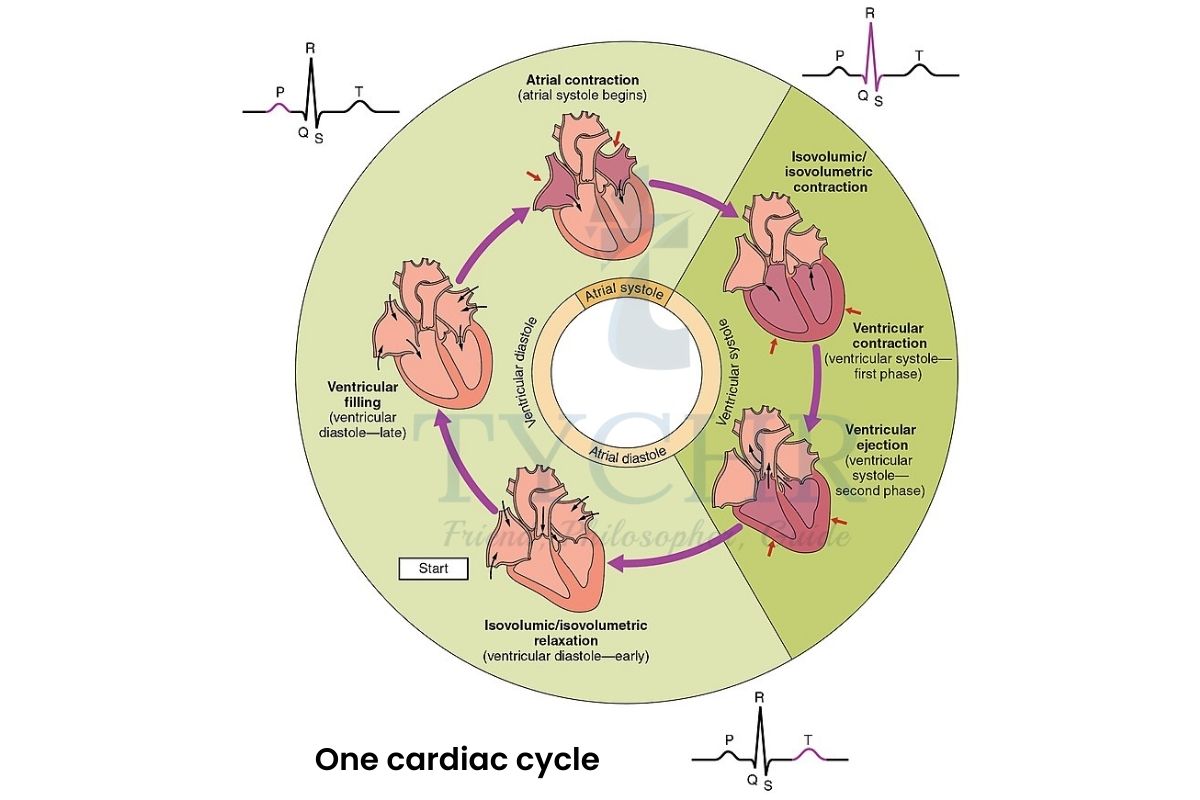
Figure 15.3 One cardiac cycle
Electrocardiogram (ECG)
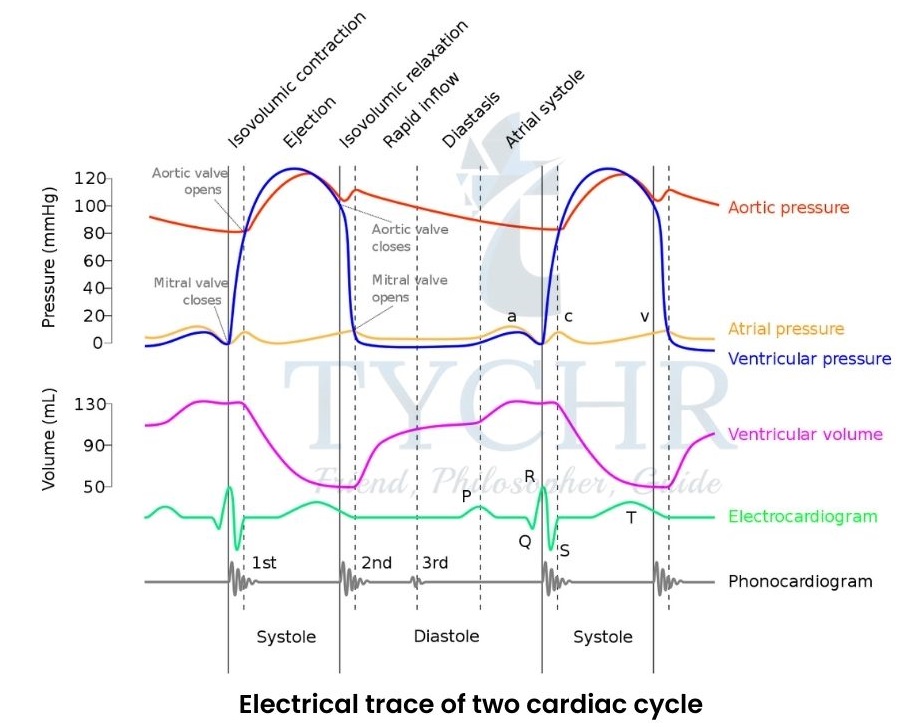
Heart and problems and their treatments
Cardiac arrest and arrhythmia
- When the heart stops working (cardiac arrest) or is no longer in sequence with the set of electrical impulses of a cardiac cycle (arrhythmia), defibrillators could be used.
- This is the device that delivers an electric shock to the heart and resets the electrical signal starting with the SA node. The resetting may cause the heart to continue with the beating.
Thrombosis
- A condition in which a clot is formed within a blood vessel causing blockage. It is more harmful when it travels to the smaller veins, specifically called deep vein thrombosis (DVT).
- It can be treated by using anticoagulants medicines.
- Coronary thrombosis: It is the clot that occurs in the coronary arteries of the heart (plaque formation), narrows the lumen and may eventually cause myocardial infarction.
Hypertension
- Plaque formation is one of the main reasons causing hypertension, another is loss of elasticity in arteries.
- There are two values of blood pressure; systolic pressure (when arteries are contracting) and diastolic pressure (when arteries are resting).
Hormones and metabolism
Endocrine system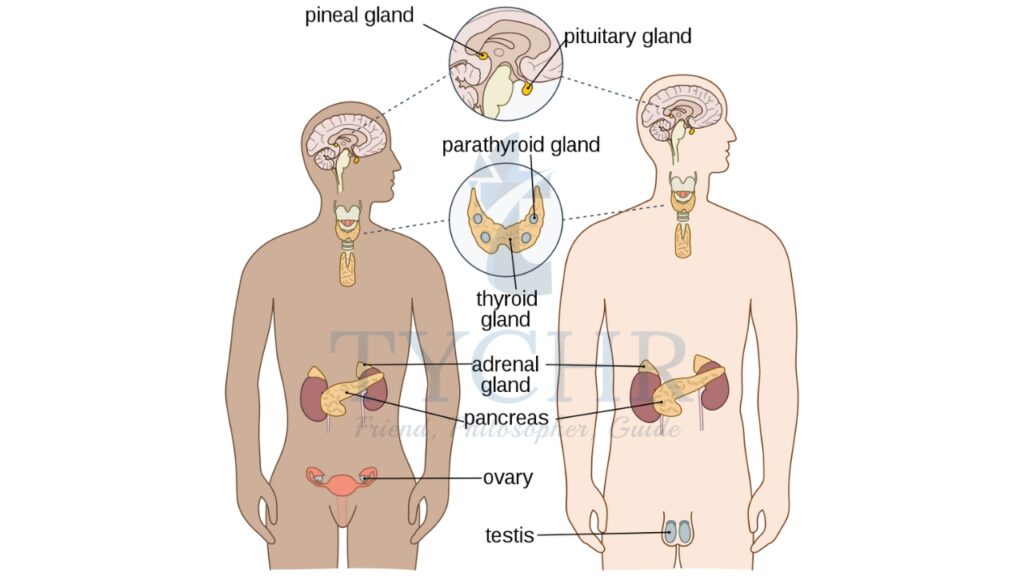
- In this system of hormone secretion, the hormones are secreted directly into the bloodstream which is accepted by the receptor molecules of the target cells.
- Some important endocrine glands are:
- Pituitary gland (anterior and posterior lobe)
- Thyroid gland
- Parathyroid glands
- Adrenal glands (occurs in pair)
- Pancreas (it has both endocrine and exocrine functions)
- Ovaries (in females)
There are two types of hormones:
- Steroid hormones
- Synthesised from cholesterol and therefore have the properties of lipid.
- They can easily pass through the cell membrane (lipid bilayer) due to its hydrophobic nature.
- The mechanism of action of steroid hormones;
The receptor protein for hormones is present inside the cytoplasm. The steroidal hormones pass the membrane and attach to the receptor molecule, forming receptor-hormone complexes. The complex then enters the nucleus and binds to a specific gene. This way they control the protein production of the target cells.
- Peptide hormones
- These are composed of amino acids and therefore have the properties of proteins. They can’t directly enter the cell membrane.
- The receptor proteins of this kind of hormones are present outside the cell membrane on which the hormones bind together.
- Mechanism of action;
Soon the hormones get attach to the receptor protein, a secondary messenger molecule is triggered into the cytoplasm which performs some more reactions to get the final molecule which can actually alter the transcription and thereby controls the protein synthesis.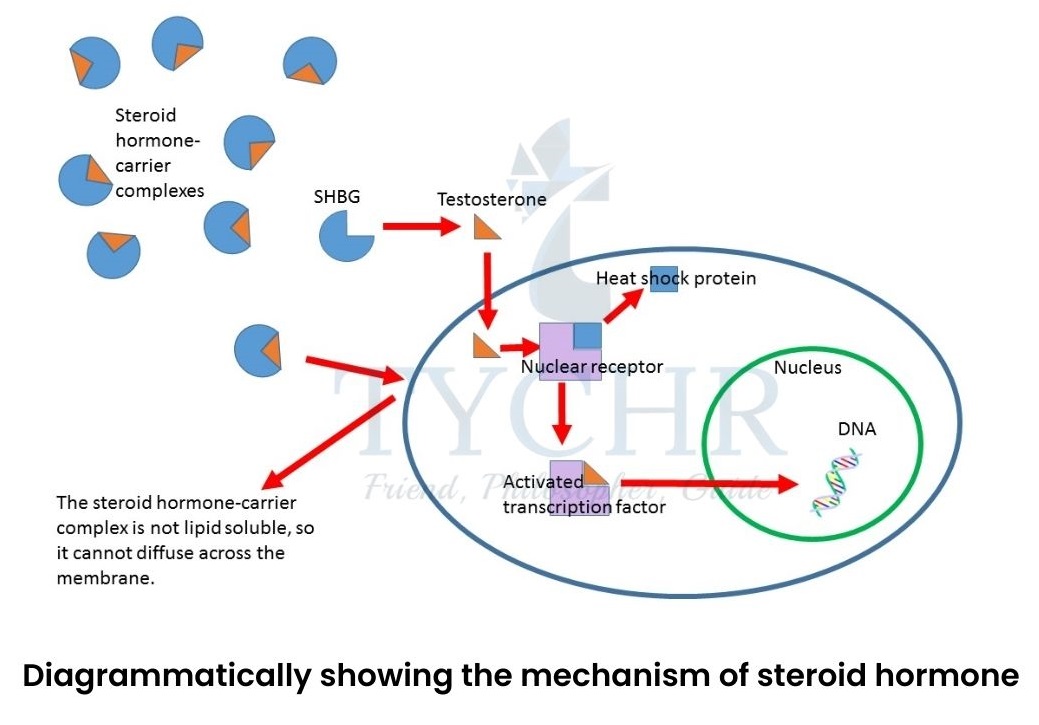
Diagrammatically showing the mechanism of steroid hormone 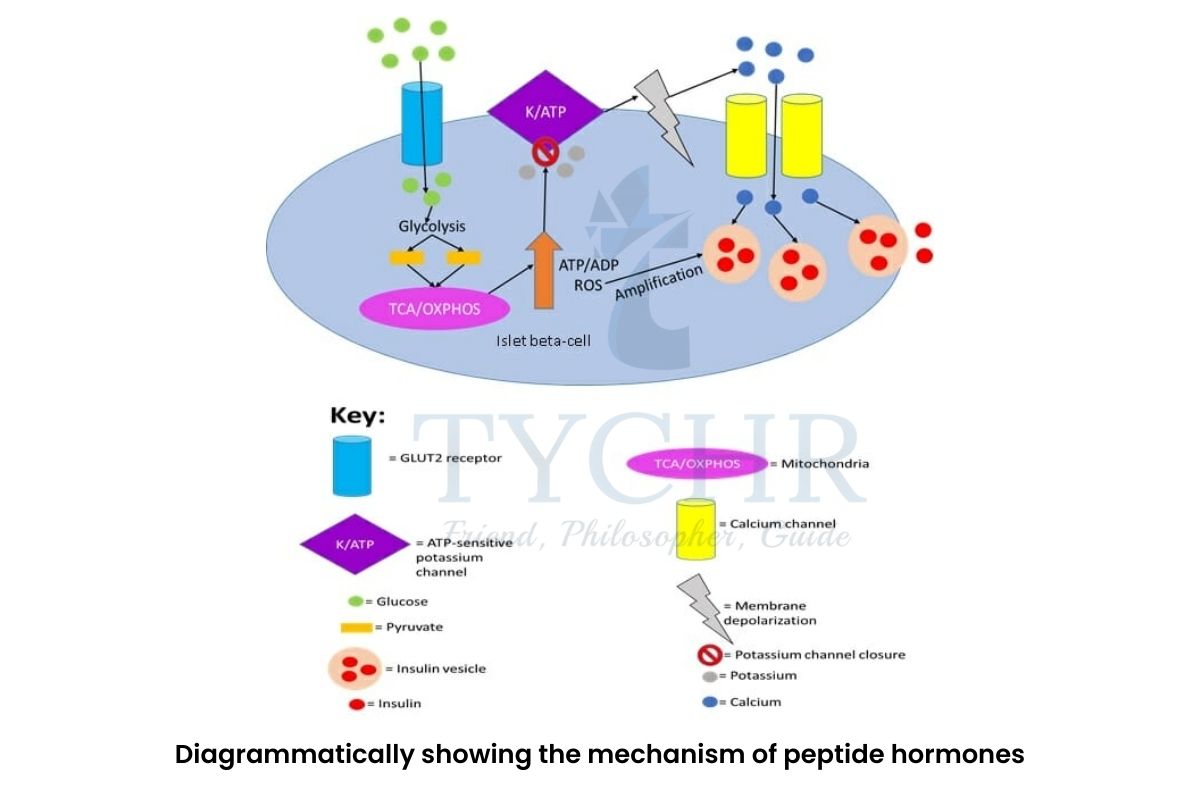
Diagrammatically showing the mechanism of peptide hormones
The pituitary gland (master gland)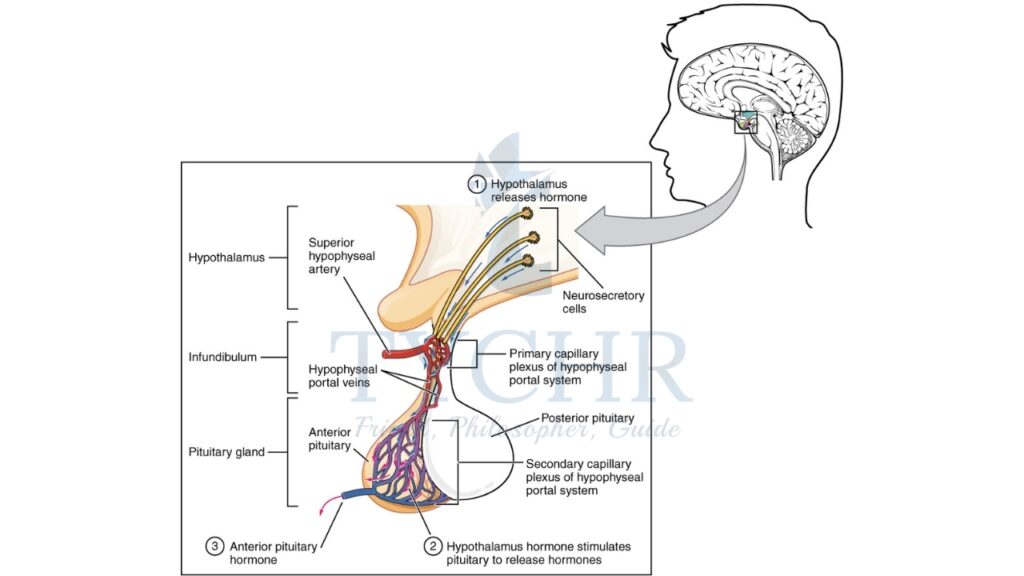
- It is called master gland because it secretes most of the hormones to stimulate a certain function in the body.
- It is divided into two lobes; posterior and anterior lobe. These lobes act as two different glands and therefore they are called posterior pituitary and anterior pituitary.
- It works under the orders of hypothalamus. Hormones are produced in the hypothalamus and travelled down to the pituitary to be secreted.
- Hormone secretions from posterior and anterior lobes of the pituitary work differently.
- Secretions through posterior pituitary;
- The hormones are produced by neurosecretory cells, which are present in a unique way. The dendrites and cell body is covered under the hypothalamus and the axon part comes under the posterior lobe.
- The cell body secretes hormones and moves down to the posterior pituitary where they mix with the capillary bed.
- The hormones produced are oxytocin and ADH.
- Secretions through anterior pituitary;
- The hormones are produced by neurosecretory cells in the hypothalamus only. They then get into the capillary bed, which collects into the portal vein.
- The portal vein travels down into the pituitary where it branches into a second capillary bed that allows it to release into the bloodstream.
- The hormones produced are thyroid stimulating hormone (TSH), FSH, LH, growth hormones (GH) and prolactin.
- The oxytocin and prolactin hormones produced by respective pituitaries have a significant role in lactation. Significance is defined below:
- Secretion of prolactin during pregnancy develops the breast to produce milk. The high oestrogen level during pregnancy inhibits milk release.
- After the birth of the child, the decline in the oestrogen production and high levels of oxytocin (due to uterine contraction) stimulates the milk secretion.
Transport of respiratory gases
Haemoglobin (Hb4)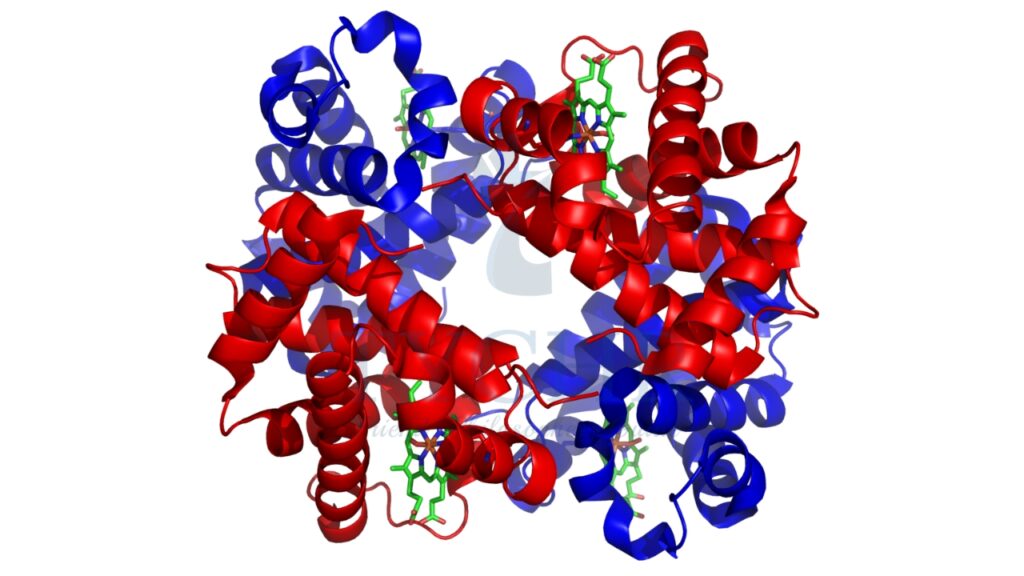
- Each haemoglobin molecule inside each erythrocyte cell can occupy four oxygen molecules at most and one CO2 molecule.
- The iron atom in the haem group bonds with oxygen i.e. four iron atoms will bond to four oxygen molecules.
- Haemoglobin changes its shape in addition to the oxygen molecule (depends on how many oxygen molecules it occupies). This is known as haemoglobin’s affinity for oxygen.
- Haemoglobin that already carries three oxygen molecules has the greater affinity for oxygen because every oxygen molecule when bonds with haemoglobin changes its shape to increase its affinity.
Training of athletes for some sports is preferably done on the high altitudes, such as to increase their haemoglobin count and number of erythrocytes. Some adaptations are needed when we are on high altitudes, therefore mountaineers spend some time at each level of altitude to let adjust their physiological system. |
Oxygen dissociation curves
- These graphs show the affinity of haemoglobin for oxygen. X-axis shows the partial pressure of the oxygen and the y-axis shows the saturation of haemoglobin.
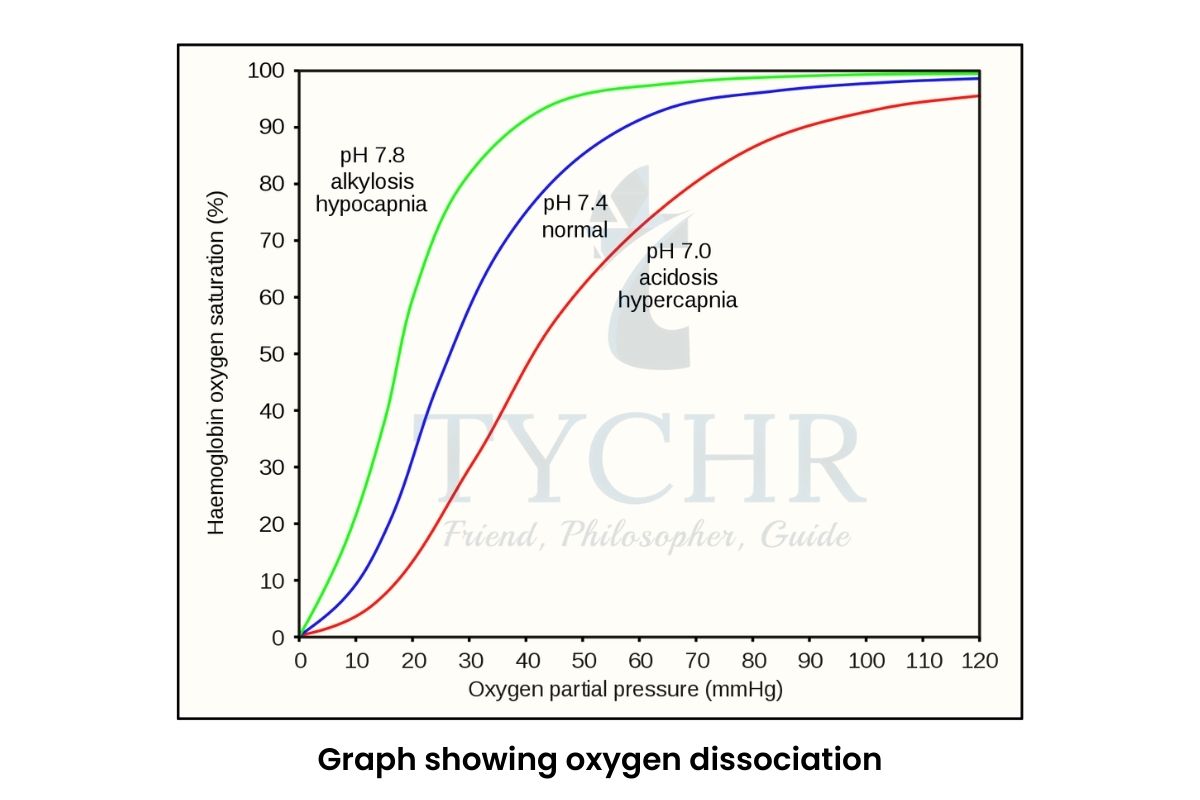
- Myoglobin molecule can occupy only one oxygen molecule. The graph of comparison of saturation of myoglobin and saturation of haemoglobin is:
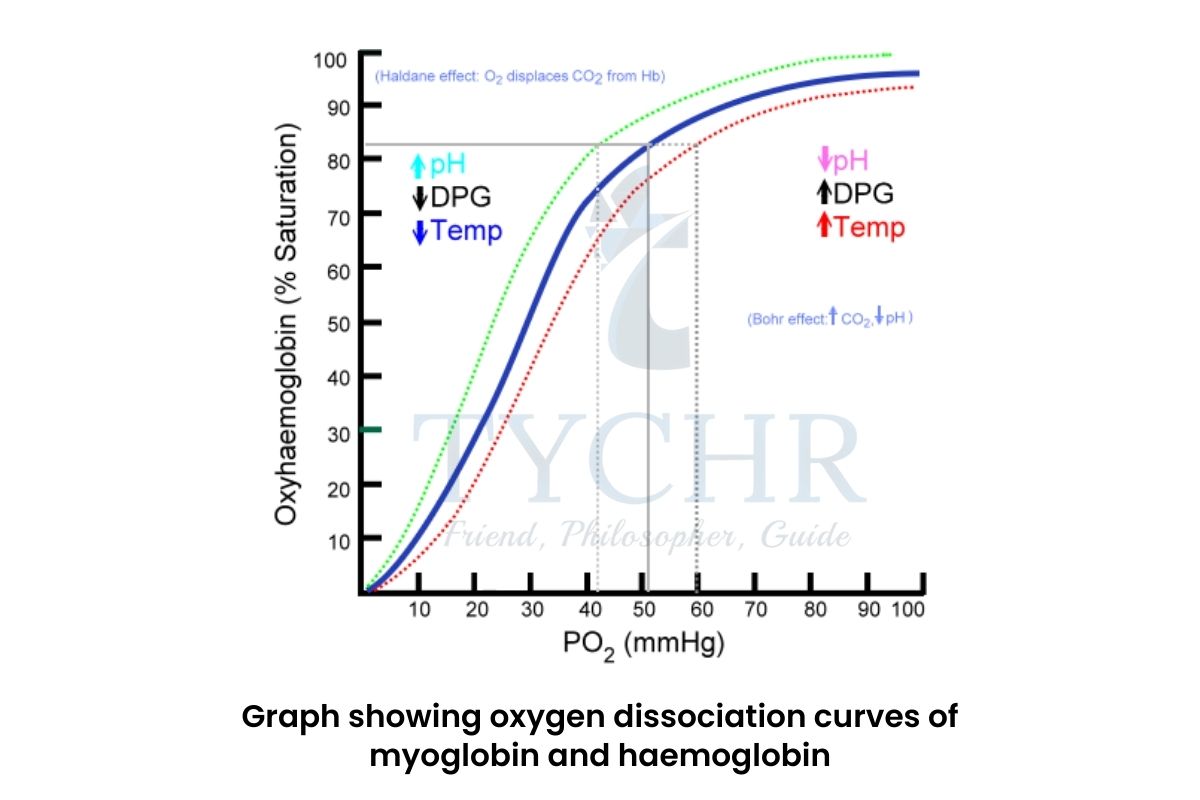
- Comparison of adult haemoglobin and foetal haemoglobin: Foetal haemoglobin has much more affinity for oxygen than adult haemoglobin because during placental exchanges the mother’s blood is working but the foetal blood is bounded to the same
oxygen molecules.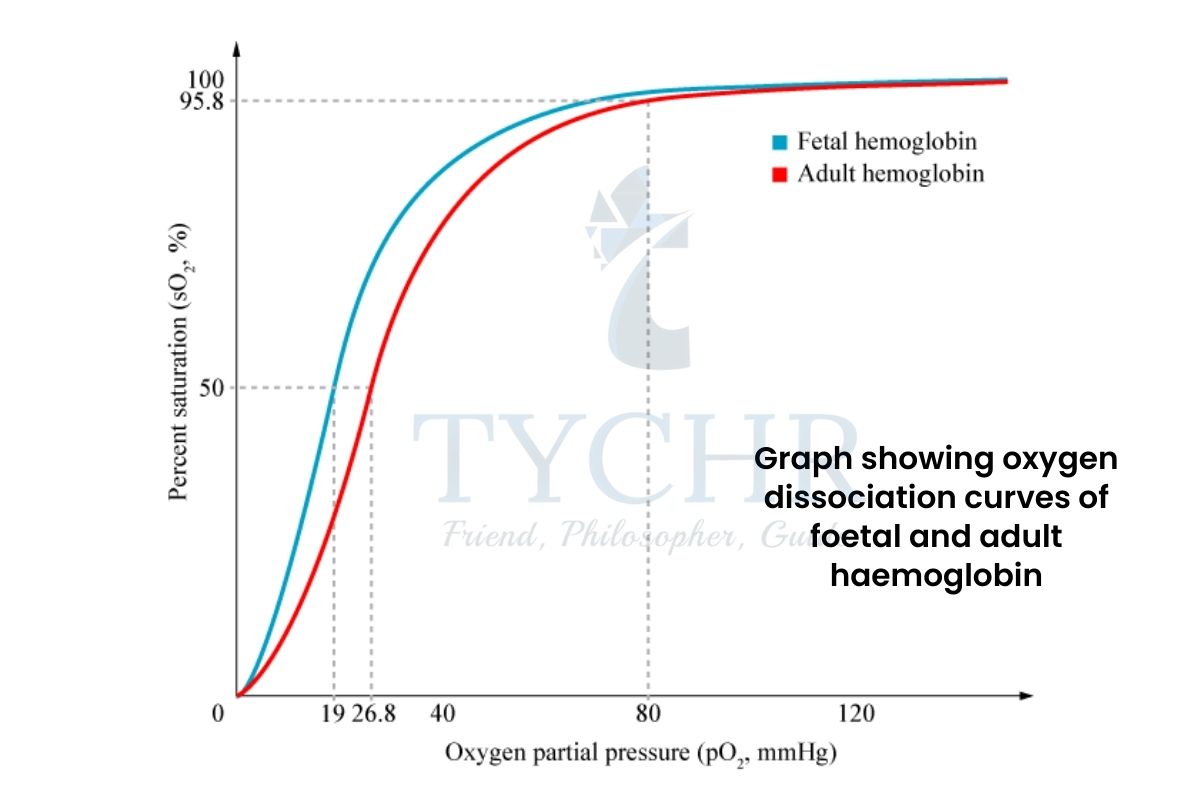
- Bohr shift
It is observed when the partial pressure of CO2 (pCO2) increased above the pO2. In this condition the haemoglobin release oxygen molecules for cell respiration and thus a shift is observed in the curves.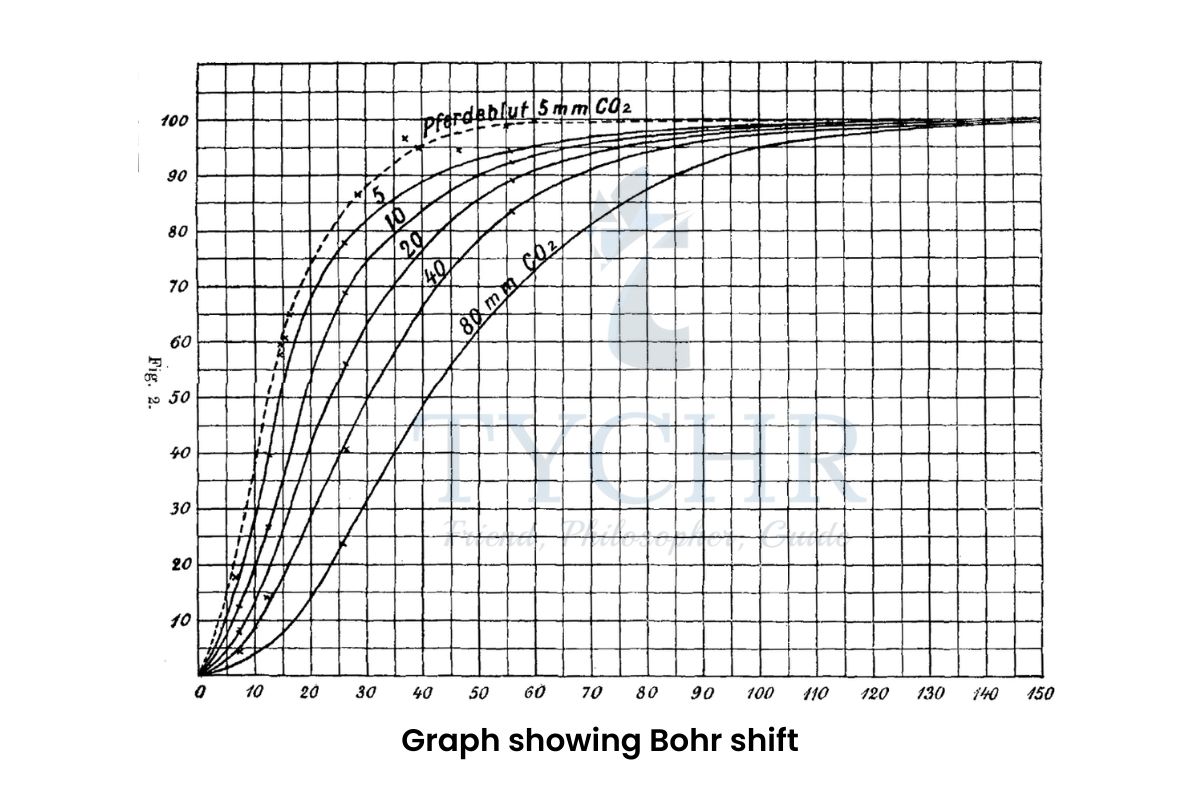
Carbon dioxide transport in the blood
- It is dissolved in blood plasma in some amount, some is carried by haemoglobin (causing Bohr shift) and most of it is converted into bicarbonate ions.
- Bicarbonate ions exit the erythrocyte cells by facilitated diffusion. One HCO3– gets out and one Cl– gets inside, as an exchange. This is called chloride shift.
- The release of H+ ions decreases the pH of the blood.
Regulation of ventilation rate
- Ventilation rate is controlled by the respiratory centre in medulla oblongata.
- The rate increases when there is more CO2 detected in blood and vice versa.
- It has developed two mechanisms to keep ventilation rate under control;
- Chemosensors are present in the inner walls of aorta and carotid arteries, which detect the CO2 levels in the blood and generate an action potential to the respiratory centre in medulla oblongata.
- These chemoreceptors are also present in the medulla oblongata itself. When the blood passes from the capillary bed in the medulla oblongata, it detects the pH decrease or high levels of CO2 in blood.
Gas exchange at high altitudes The air gets thinner as we go up on altitudes i.e. the pO2 will decrease gradually. To counter the problems that can occur due to low partial pressure of oxygen, the body’s physiological responses change in such a way:
|
Emphysema It is a lung disease in which, many lung alveoli become severe damaged with gaping holes. It may cause other damages in airways which may collectively called COPD – chronic pulmonary obstructive disease. Cause may be smoking cigarette, marijuana, air pollution etc. A little damage because of these causes of occurs to lungs, that may be treatable but if lungs become severely damaged than there will be no recovery. |

